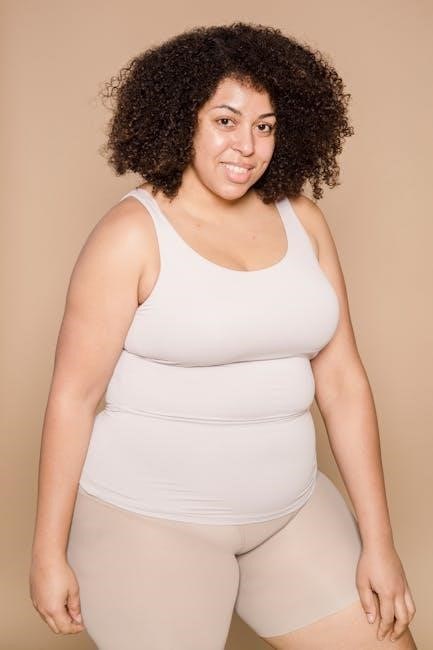Women’s T-Shirt Size Guide
Finding the perfect fitting women’s t-shirt can be challenging due to size variations across brands. This comprehensive guide provides essential tools and information to navigate sizing, ensuring you find a comfortable and flattering fit, taking measurements for comparison to size charts.
Navigating the world of women’s t-shirt sizing can often feel like deciphering a secret code. Unlike men’s sizing, which often relies primarily on chest measurements, women’s sizing considers a broader range of body dimensions, including bust, waist, and hip measurements. This complexity arises from the diverse range of body shapes and sizes that women’s clothing aims to accommodate. Adding to the confusion, sizing can vary significantly between brands, with what is considered a “small” in one store potentially being a “medium” or even a “large” in another.
This variability makes relying solely on labeled sizes unreliable. Understanding your own body measurements and comparing them to specific brand size charts is crucial for finding a t-shirt that fits well and feels comfortable. This guide aims to demystify the process, providing you with the knowledge and tools to confidently select the right size t-shirt every time. We’ll explore how to accurately measure yourself, interpret size charts, and consider the impact of different t-shirt fits on sizing.
How to Measure Your Body for T-Shirt Size
Accurate body measurements are the foundation of finding the right t-shirt size. Before consulting any size chart, take the time to measure your bust, waist, and hips correctly. For the most accurate results, wear a non-padded bra and stand in front of a mirror. Use a flexible measuring tape and ensure it is parallel to the floor.
When measuring your bust, wrap the tape around the fullest part of your chest, keeping your arms relaxed at your sides. The tape should be snug but not too tight. For your waist measurement, find the natural waistline, which is usually the narrowest part of your torso. Again, keep the tape parallel to the floor and comfortably snug. Finally, measure your hips at the fullest point, ensuring the tape remains level.
Record these measurements in inches or centimeters, depending on the size chart you plan to use. It’s helpful to have someone assist you with measuring to ensure accuracy, especially for the bust measurement. Remember, precise measurements are key to comparing yourself against brand-specific charts and selecting the most appropriate t-shirt size.
Bust Measurement
The bust measurement is crucial for determining the correct size, particularly for fitted or slim-fit t-shirts. To obtain an accurate bust measurement, stand comfortably with your arms relaxed at your sides. Ensure you are wearing a bra that you would typically wear with a t-shirt, preferably non-padded for the most precise result.
Take a flexible measuring tape and wrap it around the fullest part of your chest. The tape should be positioned horizontally, parallel to the floor, encircling your back and chest. It’s important that the tape isn’t too tight, restricting your natural shape, nor too loose, causing inaccurate results. The tape should lie comfortably against your body without digging into your skin.
Once the tape is correctly positioned, take a breath and exhale normally before reading the measurement. Note the measurement at the point where the tape meets, ensuring you’re looking directly at the tape and not at an angle. It’s always a good idea to take the measurement two or three times to ensure consistency and accuracy. Record this number, as it will be essential for comparing against size charts.
Waist Measurement
Taking an accurate waist measurement is essential for ensuring a well-fitting t-shirt, especially for styles that are tailored or have a more defined shape around the midsection. To begin, stand naturally and locate your natural waistline. This is typically the narrowest part of your torso, usually located above your belly button and below your rib cage. If you’re having trouble finding it, try bending to one side; the crease that forms indicates your natural waist.
Once you’ve identified your natural waistline, take a flexible measuring tape and wrap it around your waist, ensuring the tape is parallel to the floor. The tape should fit snugly but not too tightly, allowing for comfortable breathing. Avoid pulling the tape so tight that it digs into your skin, as this will result in an inaccurate measurement.
After positioning the tape correctly, exhale normally and read the measurement where the tape meets. Make sure you are looking directly at the tape to avoid parallax errors. For best accuracy, repeat the measurement a couple of times to ensure consistency. If the measurements vary slightly, take the average of the readings. Record this measurement, as it will be used in conjunction with the bust and hip measurements to determine your ideal t-shirt size.
Hip Measurement
Measuring your hips accurately is vital for selecting the right t-shirt size, particularly for styles that are fitted or taper towards the hips. Start by standing with your feet together and ensure you are on a flat, even surface. Locate the fullest part of your hips and buttocks; this is where you’ll take the measurement.
Take a flexible measuring tape and wrap it around your hips, ensuring the tape remains parallel to the floor. It’s crucial that the tape is positioned at the widest point to obtain an accurate measurement. Avoid pulling the tape too tightly; it should fit comfortably around your hips without digging into your skin.
Once the tape is in place, look in a mirror to ensure it is level all the way around. Read the measurement at the point where the tape meets, making sure you are looking directly at the tape to avoid any errors. For greater accuracy, it’s recommended to repeat the measurement a few times and record the average of the readings.
Keep in mind that hip measurements can vary slightly depending on posture and body composition. Use this measurement, along with your bust and waist measurements, to consult the specific brand’s size chart. This comprehensive approach will significantly improve your chances of finding a t-shirt that fits comfortably and looks flattering.
Understanding Size Charts: Brands and Variations
Navigating women’s t-shirt sizes can feel like deciphering a secret code, primarily because sizing varies significantly across different brands and retailers. What might be a size medium at one store could easily be a size small or even a large at another. This inconsistency stems from the fact that there are no standardized sizing regulations within the fashion industry, leading each brand to establish its own unique fit standards.
Therefore, it’s crucial to understand that a universal size chart simply doesn’t exist. Instead, always refer to the specific size chart provided by the brand from which you are purchasing. These charts typically include measurements for bust, waist, and hips, allowing you to compare your own body measurements to the brand’s sizing guidelines.
Furthermore, variations can occur even within the same brand due to different styles or collections. For instance, a slim-fit t-shirt will naturally have different measurements compared to a relaxed-fit one. Fabric type can also influence sizing; stretchy materials may offer more give, while non-stretch fabrics might require a more precise fit.
Before making a purchase, take the time to locate and carefully review the relevant size chart. Pay close attention to how the brand measures each dimension, as this can also differ. By understanding these nuances, you can significantly increase your chances of selecting the correct size and avoiding the frustration of ill-fitting clothing.

Common Women’s T-Shirt Sizes: XS to XXL
Women’s t-shirts commonly range in sizes from extra small (XS) to double extra large (XXL), although some brands may offer even smaller or larger sizes. Each size corresponds to a range of body measurements, typically focusing on bust, waist, and hip circumference. Understanding the general measurements associated with each size can provide a helpful starting point, but it’s essential to remember that these are approximate and vary by brand.
An extra small (XS) typically fits a bust measurement of around 32-33 inches, while a small (S) usually accommodates 34-35 inches. Medium (M) sizes often fit bust measurements between 36-38 inches, and large (L) sizes are generally suited for 39-41 inches. Extra large (XL) sizes tend to fit bust measurements of 42-45 inches, and double extra large (XXL) sizes are commonly designed for 46-48 inches.
However, it’s crucial not to rely solely on these general guidelines. Always consult the specific size chart provided by the brand you’re considering purchasing from. Additionally, consider your body shape and personal preferences; If you have broader shoulders or prefer a looser fit, you might opt for a size larger than what your measurements initially suggest. Conversely, if you prefer a more fitted style, you might choose a size smaller.
Conversion Charts: US, UK, and EU Sizes
Navigating international sizing standards for women’s t-shirts can be confusing, as US, UK, and EU systems differ significantly. Conversion charts are essential tools to bridge these discrepancies and ensure accurate size selection when purchasing from international brands or retailers. These charts provide a comparative overview, aligning equivalent sizes across the different systems based on body measurements.
Typically, a US size 6 corresponds to a UK size 10 and an EU size 38. However, it’s crucial to remember that these are general approximations. Variations exist between brands and even within brands due to different design styles.
When using conversion charts, prioritize accuracy by focusing on your body measurements rather than relying solely on the numerical size. Measure your bust, waist, and hips in inches or centimeters and then compare those measurements to the chart’s corresponding values.
Always consult the specific brand’s size chart whenever possible, as they often provide more detailed and accurate conversions tailored to their garments. Pay close attention to any notes or disclaimers accompanying the chart, as they may highlight specific sizing nuances or regional variations. If you’re between sizes, it’s generally recommended to opt for the larger size to ensure a comfortable fit.
Different T-Shirt Fits and How They Affect Sizing
The fit of a t-shirt significantly impacts how it looks and feels, influencing the size you ultimately choose. Understanding the nuances of different fits is crucial for finding a t-shirt that complements your body shape and personal style. The three most common fits are regular, slim, and relaxed, each offering a distinct silhouette and level of comfort.
A regular fit t-shirt is designed to skim the body without being too tight or too loose, providing a classic and versatile look. It generally follows the natural curves of the body but allows for ease of movement.
A slim fit t-shirt is more form-fitting, hugging closer to the body for a streamlined appearance. It accentuates the waist and bust, creating a more tailored silhouette. Due to its closer fit, you might consider sizing up for comfort, especially if you prefer a less restrictive feel.
A relaxed fit t-shirt offers a looser, more casual style. It drapes away from the body, providing a comfortable and effortless look. These t-shirts often run larger, so you might want to consider sizing down for a more fitted appearance.
When selecting a fit, consider your body type and desired style. Slim fits work well for those who want to highlight their shape, while relaxed fits are ideal for a more comfortable, laid-back look. Always consult the brand’s size chart, as fit definitions can vary.
Regular Fit

The regular fit t-shirt is a timeless and versatile option that strikes a balance between comfort and style. It’s designed to follow the natural shape of the body without being too tight or too loose, making it a flattering choice for a wide range of body types. This classic fit offers ease of movement and allows the garment to drape nicely, providing a comfortable and effortless feel.
Typically, a regular fit t-shirt will have a straight cut through the body, with sleeves that fall naturally from the shoulder. It’s neither too boxy nor too form-fitting, offering a balanced silhouette that works well for everyday wear. This style is often considered a wardrobe staple, suitable for various occasions and easily paired with different outfits.
When choosing a regular fit t-shirt, it’s still important to refer to the brand’s size chart to ensure the best possible fit. While it’s designed to be more forgiving than a slim fit, variations in sizing can occur between brands. Pay attention to the bust, waist, and hip measurements provided, and consider your personal preferences for how you like your t-shirts to fit. If you prefer a slightly looser fit, you might consider sizing up, while those who prefer a more fitted look might stick with their usual size.
Slim Fit
Slim fit t-shirts are designed to closely follow the body’s contours, creating a more tailored and streamlined silhouette. This style is cut closer to the body than a regular fit, emphasizing the waist and bust for a more defined shape. Slim fit t-shirts are often preferred by those who want a more fitted and modern look.
The key characteristic of a slim fit is its tapered design. The t-shirt narrows slightly at the waist and hugs the body more closely in the chest and shoulders. This fit is intended to minimize excess fabric and create a smooth, flattering appearance. However, it’s crucial to ensure that the t-shirt isn’t too tight, as this can restrict movement and be uncomfortable.
When selecting a slim fit t-shirt, accurate measurements are essential. Refer to the brand’s size chart and pay close attention to the bust, waist, and hip measurements. Keep in mind that slim fit styles often run smaller than regular fit t-shirts, so you may need to size up to achieve a comfortable yet flattering fit. Consider the fabric’s stretch and give, as this can impact how the t-shirt conforms to your body. If you’re between sizes, it’s generally recommended to choose the larger size for greater comfort and ease of movement.
Relaxed Fit

Relaxed fit t-shirts offer a looser, more comfortable silhouette compared to slim or regular fits. These t-shirts are designed to drape gently over the body without clinging, providing ample room for movement and a casual, effortless look. The relaxed fit is an excellent choice for those who prioritize comfort and prefer a less structured style.
The key characteristic of a relaxed fit is its generous cut. The t-shirt typically has a straighter silhouette, with minimal tapering at the waist. This allows the fabric to flow freely, creating a comfortable and breathable feel. Relaxed fit t-shirts are often favored for everyday wear, lounging, or layering.
When selecting a relaxed fit t-shirt, it’s essential to consider the overall proportions and length. While the fit is loose, you still want to ensure that the t-shirt isn’t excessively oversized, which can appear sloppy. Refer to the brand’s size chart and pay attention to the chest and length measurements. Keep in mind that relaxed fit styles generally run larger than regular fit t-shirts, so you may need to size down to achieve your desired fit. Consider the fabric’s weight and drape, as this can impact how the t-shirt hangs on your body. If you’re between sizes, it’s generally recommended to choose the smaller size for a more balanced and flattering appearance.

Specific Brand Size Guides (e.g., ASOS, Madewell, Nike)
Tall Sizes: When to Choose Them
Tall sizes in women’s t-shirts are specifically designed for individuals with a longer torso and/or longer arms. Choosing a tall size ensures a more proportional and comfortable fit compared to regular sizes, which may feel too short in the body or sleeves. If you often find that your t-shirts ride up, expose your midriff, or have sleeves that don’t reach your wrists, a tall size is likely the right choice for you.
Typically, tall sizes are recommended for women who are approximately 5’8″ (173cm) or taller. However, height is not the only factor to consider. Even if you are slightly shorter than 5’8″, you may still benefit from a tall size if you have a longer torso relative to your overall height. Measure your torso length from the base of your neck to your hips to determine if you need the extra length provided by tall sizes.
Tall sizes generally add 1-2 inches to the body length and sleeve length of a t-shirt. This seemingly small difference can significantly improve the fit and overall appearance of the garment. When shopping online, look for brands that offer specific tall size charts. These charts will provide detailed measurements for the chest, waist, and length, allowing you to accurately compare your body measurements and select the appropriate size. Don’t hesitate to check the product descriptions, as they often include information about the model’s height and the size they are wearing, which can further guide your decision.

